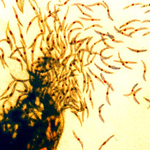Abstract
Background Mapping malaria risk is an integral component of efficient resource allocation. Routine health facility data are convenient to collect, but without information on the locations at which transmission occurred, their utility for predicting variation in risk at a sub-catchment level is presently unclear.
Methods Using routinely collected health facility level case data in Swaziland between 2011–2013, and fine scale environmental and ecological variables, this study explores the use of a hierarchical Bayesian modelling framework for downscaling risk maps from health facility catchment level to a fine scale (1 km x 1 km). Fine scale predictions were validated using known household locations of cases and a random sample of points to act as pseudo-controls.
Results Results show that fine-scale predictions were able to discriminate between cases and pseudo-controls with an AUC value of 0.84. When scaled up to catchment level, predicted numbers of cases per health facility showed broad correspondence with observed numbers of cases with little bias, with 84 of the 101 health facilities with zero cases correctly predicted as having zero cases.
Conclusions This method holds promise for helping countries in pre-elimination and elimination stages use health facility level data to produce accurate risk maps at finer scales. Further validation in other transmission settings and an evaluation of the operational value of the approach is necessary.
